Quantitative Analysis - PowerPoint PPT Presentation
1 / 30
Title:
Quantitative Analysis
Description:
describe populations on the basis of samples. test hypothesis about populations ... recoding data. can readily recode 'down' the scale (ex. ratio ... – PowerPoint PPT presentation
Number of Views:18
Avg rating:3.0/5.0
Title: Quantitative Analysis
1
QuantitativeAnalysis
2
Quantitative / Formal Methods
- objective measurement systems
- graphical methods
- statistical procedures
3
why bother?
- description
- esp. of populations
- ex average height of people in room
- inference
- describe populations on the basis of samples
- test hypothesis about populations
- estimate levels of uncertainty associated with
inferential description
4
- exploratory analysis
- pattern searching/recognition
- data mining
- evaluate strength of patterning
5
Patterning
- patterning departures from randomness
- strength of patterning ?
- ? degree of departure from randomness
6
- how likely is it that observed patterning could
have occurred by chance?? - this is a statistical question
7
- is the patterning strong enough to either
require or support an explanatory argument?? - this is usually an anthropological question
8
basic vocabulary
- case
- variable
- data matrix
- attribute
- aggregation
- stratification
- accuracy
- precision
9
- case
- equivalent to record
- something about which we want to make/record
observations - variable
- kinds of observations we want to make/record
- measurements of variability among cases
10
cases and variables
11
- attribute
- the intersection between cases and variables
- i.e., an observation about a specific case with
reference to a specific variable - ex.
- elk
- strongly agree
- plain-ware
- also called value, or variable state
12
- aggregation
- grouping cases, usually on the basis of a shared
attribute - spatial proximity, temporal proximity
- gender of interment associated with grave lots
- stratification
- dividing cases into sub-groups
- usually to carry out parallel analyses that
relate to different control conditions
13
- accuracy
- an expression of the closeness between a measured
(or computed) value and the true value - frequently confused with precision
- precision
- has to do with replicability
- the closeness of repeated measures to the same
value (not necessarily the true value)
14
scales of measurement
- presence / absence data
- simply whether or not the case exhibits a
specific state - nominal data
- contrasting groups, usually mutually exclusive
- sometimes referred to as discrete or
categorical data
15
scales of measurement
- ordinal data
- a logical order or ranking exists among the
various categories - no assumptions implied about the measurement
space occupied by categories - ratio data
- also metric, continuous
- has a non-arbitrary zero
- can meaningfully compare measurements as ratios
16
scales of measurement
- interval data
- distances between categories of measurement are
fixed and even (unlike ordinal data) - scale lacks a non-arbitrary zero (unlike ratio
data) - count data
- derived from nominal data
- really a kind of ratio data created by aggregation
17
Drennan
- distinctions are inconsistent and not too
important - measurements vs. categories
- measurements quantities measured along a scale
- categories /- equivalent to nominal data
- counts discrete enumeration
- but, confusion does occur
- ex. cant use goodness of fit tests on nominal
data!
18
data coding
- presence / absence data
- can use 0 / 1 (but analyze with care!)
- nominal data
- OK to use integers (1, 2, 3, etc.)
- but dont subject them to arithmetic operations
- dont assume rules of numerical distance
19
data coding
- ordinal data
- use integers
- ratio / metric data
- use integer or decimal notation
- dont record spurious levels of accuracy or
precision - note x 10.2 means 10.15 lt x lt 10.25
20
coding missing data
- MD more problematic than most realize
- may want more than one code
- variable state is uncertain, vs.
- variable doesnt apply, vs.
- variable state is not present (not really MD)
- R gives you one coding option (NA)
21
recoding data
- can readily recode down the scale (ex.
ratio?ordinal) - implies a loss of information and a probably
wasted recording effort - reporting apparently dubious counts as
presence/absence data is not a good idea - moving up the scale means redoing lab work
22
data management
- three main options for electronic storage of
data - spreadsheet
- statistics package
- database
23
- organized by cells
- no restrictions on cell content
- most useful for short-term manipulation of small
datasets - poor for long-term storage of complex
datastructures
spreadsheet
24
- data forms offer less versatility than
spreadsheets - organized by case variable
- powerful analytical tools
- poor management tools
stat-pac
25
- best option for managing complex data structures
database
26
pottery design elementsreptile eyeobsidian
knifecloud motif etc.
27
multiple entry
28
flat-file format
29
relational database
30
structured query language (SQL)
SELECT artifacts.catNum, design
elements.abbrevFROM design elements INNER
JOIN (artifacts INNER JOIN design element link
ON artifacts.ID design element link.artID)
ON design elements.ID design element
link.deID































